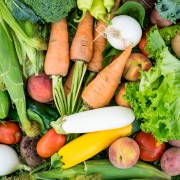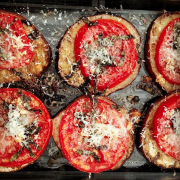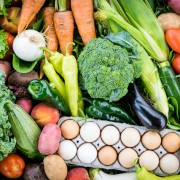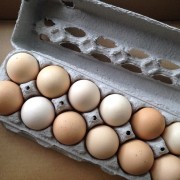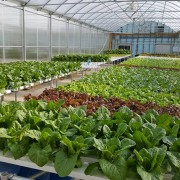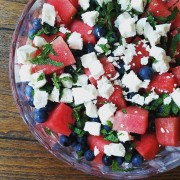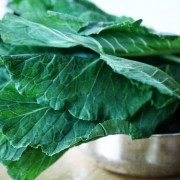Since becoming a Seasonal Roots member, I have come to appreciate all of the benefits that go along with our weekly basket of produce and local goodies. Not only does our family have access to fresh, local food on a weekly basis, but we are able to customize our basket through their online ordering options, enjoy free delivery, and support local farmers and artisans through the entire process. Add in the health benefits that are associated with eating FRESH, locally grown food, and I feel like our family hit the jackpot!
One of the unexpected benefits of our Seasonal Roots membership that I have enjoyed the most is exposure to items that our family would not normally buy at the grocery store or try otherwise. We have been LEARNING about and EXPERIMENTING with foods together as a family, and while not everything has been a hit around the dinner table, we have had fun with the process of expanding our palate and giving second chances to previously dismissed (or disliked) foods.
One of last week’s basket items offered the opportunity of a second chance. As a bonus, we received several eggplants. As beautiful as they are, they have never made their way onto my grocery list. I cannot remember ever trying eggplant as a child, and the few times that I tried it as an adult weren’t great. I just was not a fan. I thought about passing them on to a friend or neighbor, but decided that even eggplant deserved a second chance.
After a little time searching the web for some eggplant inspiration, I came up with this Baked Eggplant, Tomato, and Parmesan recipe. It is a combination of several recipes that I found online using ingredients that I already had at home: eggplant, tomatoes, Parmesan cheese, garlic, basil, oregano, olive oil, and some salt and pepper. With very little time and effort required to put this dish together, I assured myself that it was worth giving eggplant one last chance, and man am I glad that I did! This dish was a big hit in our house. So big, that we have made it twice this week and I’m still craving more.
Baked Eggplant, Tomato, and Parmesan
Ingredients:
Eggplant, sliced into ¼” – ½” slices
Tomato, sliced
Parmesan cheese, grated
Fresh basil, sliced (chiffonade*)
Garlic, finely minced
Dried oregano
Salt and pepper, to taste
Olive oil
Directions:
- Preheat oven to 350 degrees. Lightly oil a baking dish.
- Place sliced eggplant in a single layer in oiled baking dish. Layer with tomato slices, garlic, oregano, and basil. Season with salt and pepper. Top with grated Parmesan.
- Bake at 350 degrees for 35-40 minutes. Broil for last 5 minutes until eggplant is tender and slightly browned.
- Remove from oven and sprinkle with a little extra Parmesan. Serve and enjoy!
*Not sure how to chiffonade basil? Check out this video: http://www.myrecipes.com/how-to/video/slicing-basil
Still need convincing to give Eggplant a second chance? Check out some of its many health benefits:
Antioxidant Activity
Eggplant contains several phytonutrients with good antioxidant activity: caffeic, chlorogenic acid and the flavonoid, nasunin.
Heart Health
Animal studies show that eggplant may help lower overall cholesterol in the body and help to improve blood flow. The antioxidant compounds in eggplant help to prevent oxidative stress to the cardiovascular system and thus reduce the risk of heart attack and heart disease. Eggplant is also a good source of fiber, which is needed to maintain good cardiovascular health.
Brain Health
Eggplant contains nasunin, an antioxidant anthocyanin, which may help to promote healthy brain function.
Fiber
One cup of eggplant contains about 8% the DV of dietary fiber. Fiber can aid in digestion and weight loss. It helps to balance the metabolism. The fiber in eggplant helps to reduce cholesterol and relax blood vessels, which suggests it may play a productive role in maintaining good heart health.
High In B Vitamins
Eggplant is rich in vitamins B1, B3 and B6. B vitamins play an essential role in the proper function of the central nervous system, energy production, hormone balance and healthy liver function. They are also believed to help balance blood sugar and reduce cholesterol.
Weight Loss
Maintaining the proper DV of fiber and B vitamins can be a great way to contribute to healthy weight loss. Fiber promotes a healthy, active metabolism and B vitamins can help the body to process fat. Eggplant is also rich with nutrients while offering very few calories (only 19 per cup), which makes it a great addition to an active, effective weight loss program.
Bone Health
Eggplant contains many of the minerals needed to maintain strong, healthy bones: manganese, potassium, magnesium and copper.
Cancer Prevention
Many doctors and scientists believe that a compound in eggplant can effectively treat certain types of skin cancer. The phytochemical, known as BEC5, is believed to kill cancer cells without harming healthy cells.
Sarah Young is a wife, mother of three, Certified Health Education Specialist, and healthy living advocate. She has a background in Dietetics and a B.S. in Health, Fitness, and Recreational Resources with a concentration in Health Promotion. She is also a writer for several local and online publications, an ambassador for the Jamie Oliver Food Foundation, and a health contributor for ABC 7 News/WJLA. In her spare time, she enjoys running, hiking, gardening, and spending time with her family and their dog, Maple.
